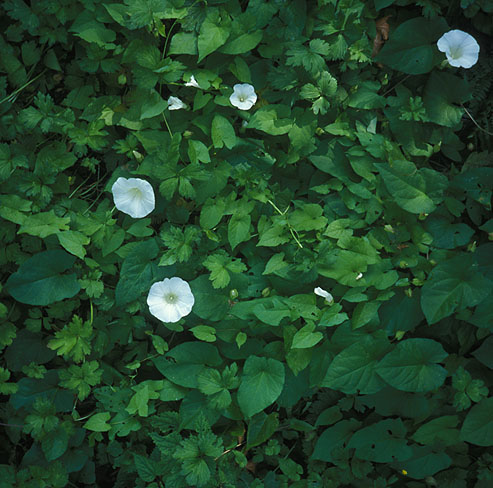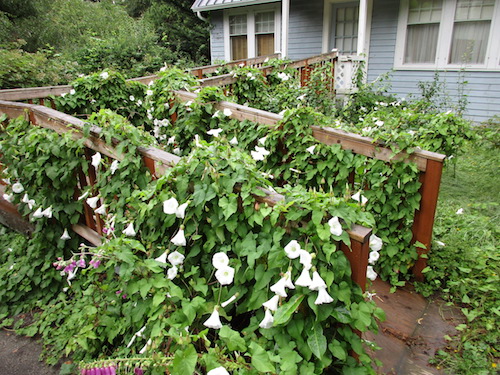
|

|
| Wild Morning-Glory; Calystegia sepium (L.) R. Br. |
Bindweed Family; CONVOLVULACEÆ
|
| Seattle's common morning-glory is an obnoxious, deciduous vine with thick, spreading perennial roots. Frost yellows and kills the above ground parts each winter. March brings eager new shoots above ground, rubbery, skinny stems twisting clockwise, clambering and twining, reaching sometimes by the end of the season 30 feet into trees or telephone poles. |
| Arrowhead-shaped leaves of flaccid, limp, dull character, often bug-eaten, are background to big funnel-shaped white or weakly pink-tinged flowers from June through October. The scentless, fleeting flowers are pollinated by moths in the night. At 8:30 in the morning you can see why they earned their name: their glory then is precious to behold. |
| The stems along the soil surface can send down roots. The spaghetti-like roots themselves, up to a quarter-inch thick, mostly spread horizontally in the topsoil. Like dandelion roots, they exude a sticky white milky latex, and if chopped into pieces and boiled, make a nutritious, satisfying meal, albeit blandly flavored. In parts of east Asia, the young spring shoots are similarly used as a cooked green. |
| The species here considered (also called Convolvulus sepium L.) has a wide natural distribution and consists of several races. Its sylvatica subspecies is our ubiquitous, very familiar Morning Glory, with flowers about 4 inches wide. Other kinds (none native) exist both wild and cultivated hereabouts, but none are as strong or large. |
| In the Language of Flowers the foul pest signifies with perfect appropriateness either "Extinguish" or "Insinuation"! English names include: Hedge Bindweed, Great Bindweed, Larger Bindweed, Bell Bind, Rutland Beauty, Lady's Nightcap, Pisspot, Devil's Vine, and Hellweed. What a reputation! |
This grasping parasite is a much hated weed due to its overbearing, gripping, smothering ruthlessness. Gardeners forced to rip it out of their cherished plants find the job slimy, fetid, messy; and are madly driven to profane exclamations and dreams of herbicides. If a garden is well infested with it, several years of thorough hand-weeding, or some careful herbicide applications are necessary to completely kill it. To ignore fighting it, means the garden will grow ever more "in a bind."
|
Originally published as the Seattle Tilth newsletter Weed of the Month in July 1987, along with an illustration drawn by Jerri Geer.
Back |
|
|

